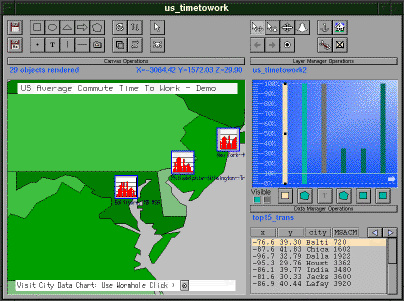![]()
Tioga DataSplash (formerly known as Tioga-2) allows users to interactively create and browse visualizations of database tables. DataSplash was developed by members of the Tioga Project at the University of California at Berkeley. DataSplash software is available on Alpha/OSF, HP/UX, Intel/Linux, and Sparc ®/Solaris platforms. We are porting to other UNIX platforms as well.
DataSplash integrates two main components, a paint program and a navigation system. The following section describes these components in more detail. You may wish to read this description or you may wish to visit one of the following parts of our site:
As in a conventional paint program, the DataSplash user is presented with a palette of displayable objects (point, line, etc.). To draw an object, the user selects the corresponding paint primitive from the paint palette and places it in a two-dimensional canvas. A single such object is called a trim object. Examples of useful trim objects include titles and legends.
Unlike a standard paint program, DataSplash contains a window that shows rows from a database table to be visualized. Each row is assigned an x,y location in the canvas, i.e., the rows are scattered across the canvas, giving an effect similar to a scatter plot. For example, if the user has a table of United States cities with latitude and longitude columns, x and y can be assigned to the longitude and latitude values of each city.
At any point, the user can select an object in the canvas and duplicate it for every row in the database table. As a result, a copy of the object appears at the x,y location of every row in the table. The effect is like splashing paint across the canvas, coating every scattered row; these are splash objects. The user may also associate display properties of objects with columns in the table, e.g., height, width, color, and rotation of each splash object can be derived from values in the columns of its row.
DataSplash incorporates a sophisticated navigation model. Users can pan, zoom, teleport, and link to other canvases. Objects change representation as users zoom closer to them. DataSplash provides a unique mechanism, a layer manager, which allows end users to visually program the way objects behave during zooming. DataSplash also provides portals (formerly known as wormholes, portals are windows which go to other canvases). DataSplash users can automatically generate a portal for every row in a database table. Suppose the user has a canvas with a map of the United States. The user can easily specify that each city in the United States map should have a portal which goes to a map of that city.
The figure below is a screen shot of DataSplash. To see other sample visualizations, visit our Splashes page.

There are several other interesting visualization projects. The interested reader is referred to related work for more information.
![]()